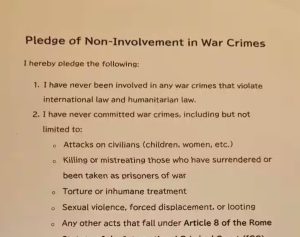
Prime Minister Fumio Kishida holds a press conference announcing the decision on the "Three Security Documents," including the new National Security Strategy, at the prime minister's office on December 16, 2022. (©Sankei by Yasuhiro Yajima)
A joint statement on a meeting of the Japan-US Security Consultative Committee in Washington on January 11 said that the Japanese and United States foreign and defense ministers at the so-called 2+2 meeting "committed to expand joint/shared use of US and Japanese facilities and to increase bilateral exercises and training in areas including Japan's Southwest Islands." The 2+2 joint statement was based on Japan's three national security documents, adopted by the government late in 2022.
Japanese ministers made the commitment. Therefore, the US side might have concluded that United States forces may be allowed to use Japanese facilities.
Okinawa Rejects Military Use of Shimojishima Airport
The US Marine Corps told the Okinawa Prefecture government on January 13 that it would like to use Shimojishima Airport on Okinawa's Shimoji Island. The use would be for training flights for humanitarian assistance and disaster relief. However, the prefectural government asked the US to refrain from using it.
The grounds were based on a memorandum signed in 1971 between the Japanese government and Chobyo Yara. He was then chief executive of the Government of the Ryukyu Islands under the US administration. The document stipulated that the airport would not be used for military purposes. As a result, the commitment at the 2+2 meeting failed to be fulfilled.
Okinawa's rejection of the military use of Shimojishima Airport runs counter to the three National Security documents. The three call for expanding the use of civilian airports and seaports.

The Three Key Security Documents
"Specifically, as part of the reinforcement of the comprehensive defense architecture, Japan will establish a cross-governmental mechanism to develop and enhance the functions of public infrastructure such as airports and seaports based on the needs of the JSDF [Self-Defense Forces] and the JCG [Japan Coast Guard] for their smooth utilization and deployment in response to protection of its nationals, peacetime training, and deployment during contingencies." This is said in the National Security Strategy of Japan, one of the three documents.
"Based on defense needs, under the inter-agency mechanism for strengthening comprehensive defense architecture, the government will develop and upgrade airports, seaports and other facilities, particularly in the southwestern region." This is a quote from the National Defense Strategy, another one of the three documents. "To enable the SDF to use, for purposes including peacetime training, facilities such as existing airports and seaports as operation infrastructure, the government will take necessary measures such as the establishment of a framework for interagency coordination."
Civilian Airports and Seaports Mentioned Explicitly
"In addition to expanding […] the use of civilian airport and seaport facilities, the MOD [Ministry of Defense]/SDF will enhance training for rapid deployment of its units to islands such as those in the southwestern region." This is said in the Defense Buildup Program, also one of the documents.
A panel of experts published a report before the adoption of the three national security documents. It said that the entire government should make peacetime preparations for airports and seaports that are assumed to be used by the JSDF and JGC. They were referring to uses in an emergency and those required for protecting citizens. Soon after the report was published, I pointed out that the problem was how to realize the preparations.

3,000-Meter Runways Required for Evacuating Islanders
It is extremely unfortunate for Okinawans that Shimojishima Airport fails to be used due to a memorandum signed more than a half-century ago. The airport has a 3,000-meter runway for large military aircraft. For example, for evacuating people in an emergency like a Taiwan contingency.
Military ships that can transport more evacuees than aircraft are also effectively barred from civilian seaports in Okinawa Prefecture. (JINF Viewpoints "Maritime Self-Defense Force ships are effectively barred from Okinawa seaports," in Japanese. November 14, 2022.)
Japan's national security environment has turned around in the past half-century. Unless Japan implements commitments in the three national security documents and the 2+2 statement, which might include the government's direct control of airports and seaports, the United States as a Japanese ally to fight with Japan may lose confidence in Japan.
RELATED:
- [Asia's Next Page] Japan's National Security Strategy: On Road to Upending Post-War Pacifism?
- A New US National Security Strategy Identifies China as its Only Competitor: Asian Allies Are Responding
- EDITORIAL | Japan's National Security Strategy a Fulfillment of Duty to Its People
(A version of this article was first published by the Japan Institute for National Fundamentals. Find it in Speaking Out #1002 in Japanese on January 23 and in English on January 25, 2023.)
Author: Fumio Ota
Fumio Ota is a councilor and a Planning Committee member at the Japan Institute for National Fundamentals. He is a retired Vice Admiral of the Japan Maritime Self-Defense Force.







